Did you know that Eritrea, a small country in East Africa, is actively working towards preserving its biodiversity and promoting sustainable development initiatives? Despite its size, Eritrea has implemented a National Biodiversity Strategy and Action Plan (NBSAP) to safeguard its unique ecosystems and species. The country recognizes the importance of environmental conservation in shaping its future.
Key Takeaways:
- Eritrea has a comprehensive National Biodiversity Strategy and Action Plan (NBSAP) to guide its conservation efforts.
- The country aims to preserve terrestrial, coastal, marine, and island biodiversity.
- Eritrea has established protected areas, implemented sustainable land management practices, and regulated fishing activities to protect its ecosystems.
- Efforts are underway to integrate biodiversity concerns into urban planning and promote eco-friendly construction.
- Eritrea’s commitment to biodiversity conservation aligns with its goals for sustainable development.
The Status of Biodiversity in Eritrea
Eritrea, a country blessed with diverse terrestrial and marine ecosystems, is committed to preserving its rich biodiversity. From lush forests and woodlands to vibrant grasslands and coastal areas, Eritrea’s natural environment is home to a wide array of plant and animal species. The country has undertaken various initiatives to ensure the long-term sustainability of its precious natural resources and promote biodiversity preservation efforts.
One of the key strategies employed by Eritrea is the designation of protected areas. These areas act as havens for endemic and endangered species, safeguarding their habitats from human encroachment and providing safe havens for breeding and migration. By protecting these critical ecosystems, Eritrea aims to maintain the delicate balance of its biodiversity and promote the conservation of its unique flora and fauna.
Eritrea also places a strong emphasis on implementing sustainable land management practices. By adopting eco-friendly agricultural techniques and promoting responsible land use, the country aims to minimize the negative impact on biodiversity while ensuring the productivity and resilience of its ecosystems. Through sustainable land management, Eritrea strives to strike a harmonious balance between human activities and the preservation of its natural resources.
Eritrea’s Natural Resources Management
Eritrea recognizes the importance of effective natural resource management in preserving its biodiversity. The country has implemented comprehensive measures to manage its natural resources sustainably and protect its ecosystems. By implementing sustainable forestry practices, Eritrea seeks to minimize deforestation and promote reforestation efforts, ensuring the long-term health of its forests and woodlands.
Eritrea’s coastal areas are equally valuable, boasting rich marine biodiversity. The country has implemented measures to regulate fishing activities, ensuring the sustainable exploitation of its marine resources. By promoting responsible fishing practices and protecting vulnerable marine habitats, Eritrea aims to conserve its diverse marine ecosystems and the species that rely on them.
Through effective biodiversity preservation efforts and natural resources management, Eritrea remains committed to protecting its unique ecosystems and maintaining the rich biodiversity that defines the country’s natural heritage.
Eritrea’s National Biodiversity Strategy and Action Plan
Eritrea is dedicated to the conservation of its unique biodiversity through the implementation of the National Biodiversity Strategy and Action Plan (NBSAP). This comprehensive plan outlines the vision, mission, and objectives for biodiversity preservation in the country.
The NBSAP addresses various ecosystem-specific targets, aiming to ensure the sustainable management of Eritrea’s diverse ecosystems and the protection of its rich biodiversity. The plan includes specific targets for conserving terrestrial biodiversity, coastal, marine and island biodiversity, and agricultural biodiversity.
For terrestrial biodiversity, the NBSAP sets goals for the preservation of forests, woodlands, grasslands, and other natural habitats. It emphasizes the need to protect and restore endangered species and their habitats.
In terms of coastal, marine, and island biodiversity, Eritrea’s NBSAP focuses on the conservation of coral reefs, mangroves, and other valuable marine ecosystems. It also promotes sustainable fishing practices and the establishment of marine protected areas.
Agricultural biodiversity is a significant component of Eritrea’s NBSAP, with targets aimed at preserving crop genetic diversity and promoting sustainable agriculture. The plan emphasizes the importance of traditional crop varieties and sustainable livestock management practices.
Eritrea’s National Biodiversity Strategy and Action Plan serves as a roadmap for the country’s conservation efforts. By striving to achieve these biodiversity targets, Eritrea is enhancing the resilience and sustainability of its ecosystems, ensuring a harmonious coexistence between nature and human development.
Example Table: Eritrea’s Biodiversity Targets
| Ecosystem |
Biodiversity Targets |
| Terrestrial Biodiversity |
1. Preserve and expand forest areas
2. Restore degraded habitats
3. Protect endangered species |
| Coastal, Marine, and Island Biodiversity |
1. Maintain healthy coral reefs and mangroves
2. Regulate fishing activities
3. Establish marine protected areas |
| Agricultural Biodiversity |
1. Preserve crop genetic diversity
2. Promote sustainable livestock management
3. Support traditional crop varieties |
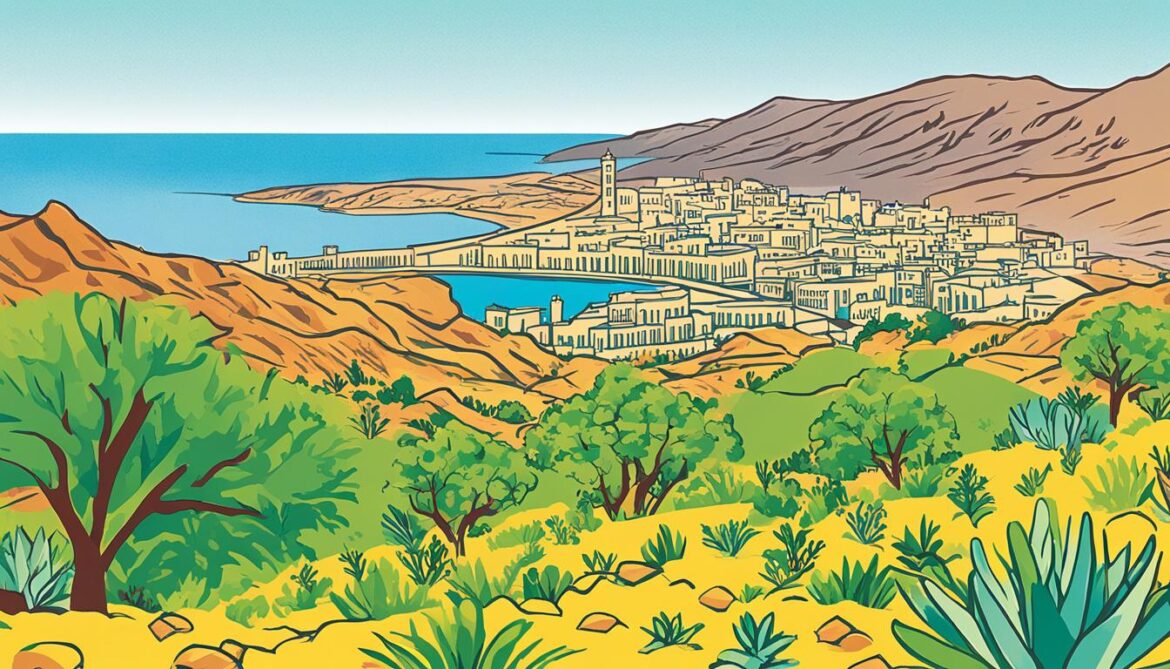
Institutional Framework for Biodiversity Conservation
Eritrea has recognized the importance of establishing a robust institutional framework to support biodiversity conservation within its borders. This framework consists of various government departments and agencies dedicated to environmental management and conservation. Their collective efforts work towards the implementation of the National Biodiversity Strategy and Action Plan (NBSAP) and the accomplishment of ecosystem-specific targets.
At the heart of Eritrea’s institutional context is the coordination and collaboration among these departments and agencies. The Ministry of Agriculture, Ministry of Land, Water and Environment, and Ministry of Fisheries are key players in the nation’s biodiversity conservation efforts. With interdepartmental cooperation, Eritrea ensures a comprehensive approach to protecting its unique ecosystems and wildlife.
Eritrea’s policy and legal framework provide the necessary guidance for effective biodiversity conservation. The country has developed national-level policies that outline key principles and objectives for conserving its natural resources. These policies are designed to align with international frameworks and agreements, further demonstrating Eritrea’s commitment to biodiversity preservation.
Furthermore, Eritrea has enacted legislation that enforces the implementation of biodiversity conservation measures. These laws establish clear guidelines for sustainable land management practices, protected area management, and the regulation of resource-use activities. They provide a solid foundation for Eritrea to safeguard its ecosystems and species for future generations.
Eritrea’s institutional context, supported by its policy and legal framework, serves as a catalyst for biodiversity conservation. Through effective collaboration and implementation of relevant legislation, the country strengthens its commitment to preserving its natural heritage.
To better illustrate Eritrea’s institutional framework for biodiversity conservation, the following table highlights key government departments, agencies, policies, and laws:
| Government Departments and Agencies |
Policies |
Laws |
| Ministry of Agriculture |
National Biodiversity Strategy and Action Plan (NBSAP) |
Biodiversity Management Proclamation |
| Ministry of Land, Water and Environment |
Environmental Policy |
Protected Areas Proclamation |
| Ministry of Fisheries |
Marine Biodiversity Conservation Policy |
Wildlife Conservation Proclamation |
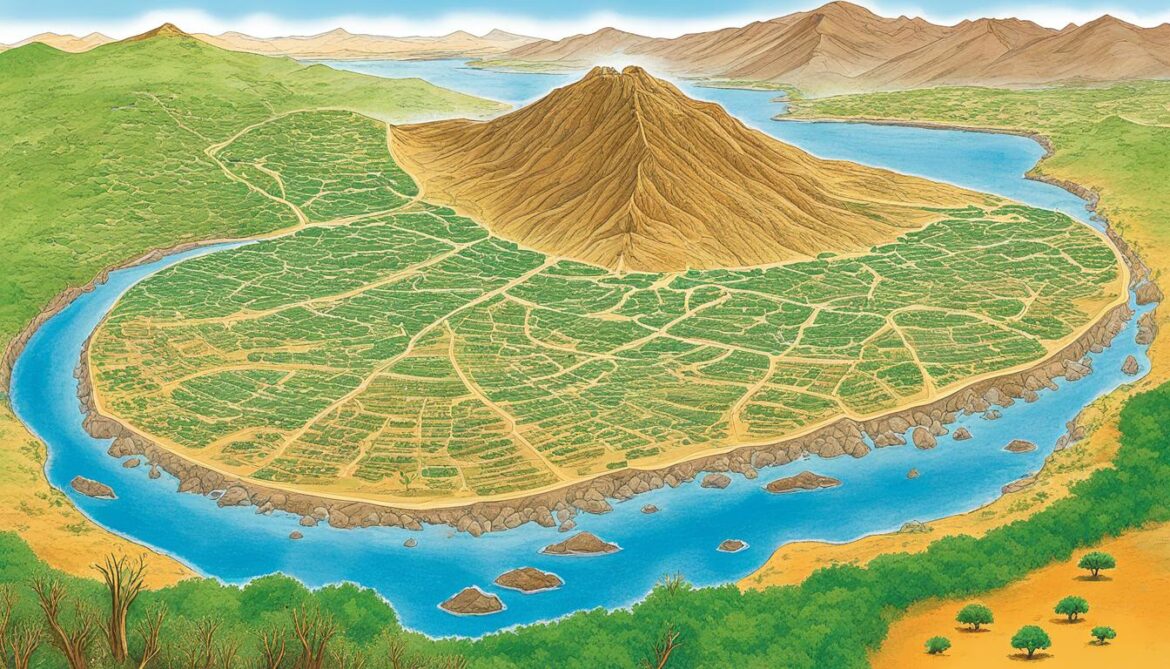
Eritrea’s Approach to Terrestrial Biodiversity Conservation
Eritrea recognizes the immense value of terrestrial biodiversity and is committed to its conservation. The country employs a comprehensive approach that encompasses both ecosystem-level conservation and species-level conservation.
Ecosystem-level conservation entails safeguarding entire ecosystems and their functions. To achieve this, Eritrea has established protected areas that serve as sanctuaries for diverse flora and fauna. These areas act as vital havens for endangered species and contribute to the preservation of essential ecological processes.
Species-level conservation in Eritrea focuses on the preservation of individual plant and animal species. The country places special emphasis on protecting endemic species unique to its ecosystems and habitats. Efforts are made to ensure their survival and prevent their extinction.
Eritrea’s commitment to terrestrial biodiversity conservation is evident in its implementation of sustainable land management practices. By promoting responsible land use, the country aims to minimize habitat degradation and maintain ecosystem resilience.
Eritrea also emphasizes the monitoring of biodiversity indicators. Regular assessment and evaluation allow for the identification of potential threats to biodiversity and the formulation of effective conservation strategies.
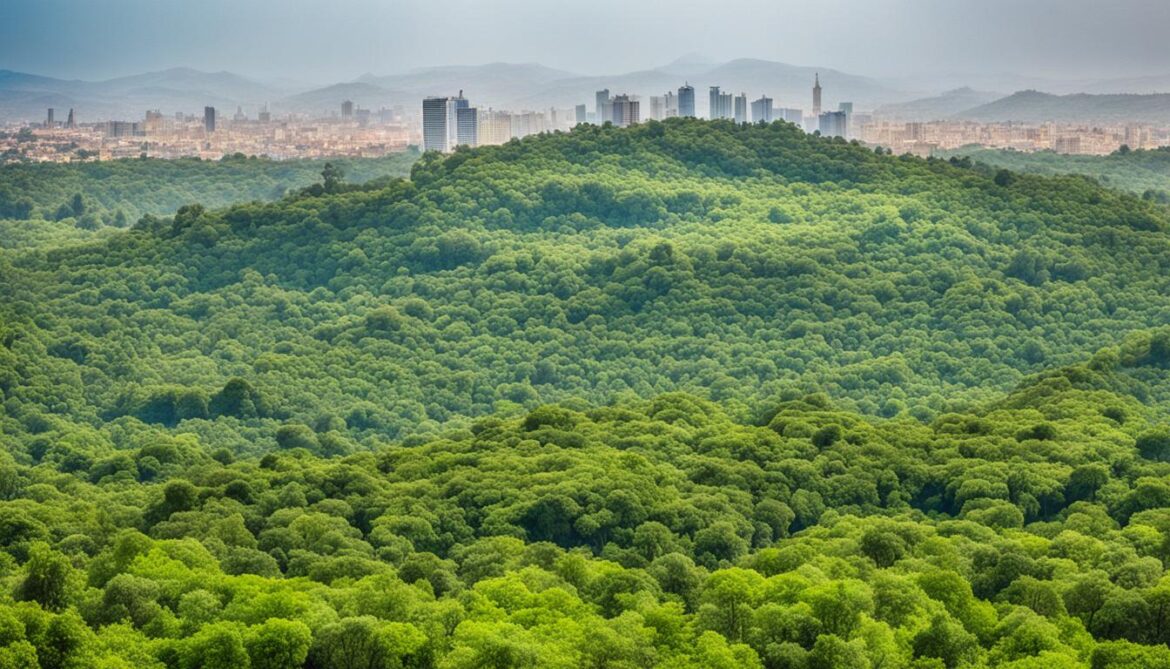
Eritrea’s approach to terrestrial biodiversity conservation is multifaceted and holistic. It encompasses the protection of entire ecosystems, the preservation of unique species, sustainable land management practices, and proactive monitoring. These concerted efforts not only uphold the country’s rich natural heritage but also contribute to the global conservation agenda.
Conservation of Coastal, Marine, and Island Biodiversity
Eritrea boasts a diverse range of ecosystems, including its valuable coastal, marine, and island environments, which play a vital role in the country’s ecological health and economic well-being. Recognizing the importance of these unique ecosystems, Eritrea has implemented stringent measures to protect and conserve their biodiversity.
One of the key conservation efforts is the establishment of marine protected areas (MPAs), which safeguard critical habitats and preserve the delicate balance of marine life. These MPAs serve as sanctuaries for a wide variety of marine species, ensuring the long-term sustainability of coastal and marine biodiversity.
“The protection of our coastal, marine, and island biodiversity is crucial for the preservation of our natural heritage and the future prosperity of our nation.”
Eritrea also takes a proactive approach in regulating fishing activities to mitigate the depletion of marine resources. By implementing sustainable fishing practices and enforcing regulations, Eritrea aims to maintain the ecological integrity of its coastal and marine ecosystems while promoting the well-being of local communities dependent on these resources.
To ensure the health and diversity of coastal, marine, and island ecosystems, Eritrea conducts regular research and monitoring programs. These initiatives provide valuable insights into the status of marine biodiversity, including the abundance and distribution of species, as well as the overall health of ecosystems.
Benefits of Conservation
The preservation of coastal, marine, and island biodiversity offers numerous benefits to Eritrea:
- Protection of critical habitats and the preservation of unique species
- Strengthening of ecological resilience and resistance to climate change impacts
- Promotion of sustainable tourism, benefiting local communities and the national economy
- Maintenance of food security and livelihoods for coastal communities
Eritrea’s commitment towards the conservation of its coastal, marine, and island biodiversity reflects its dedication to sustainable development and the responsible stewardship of natural resources.
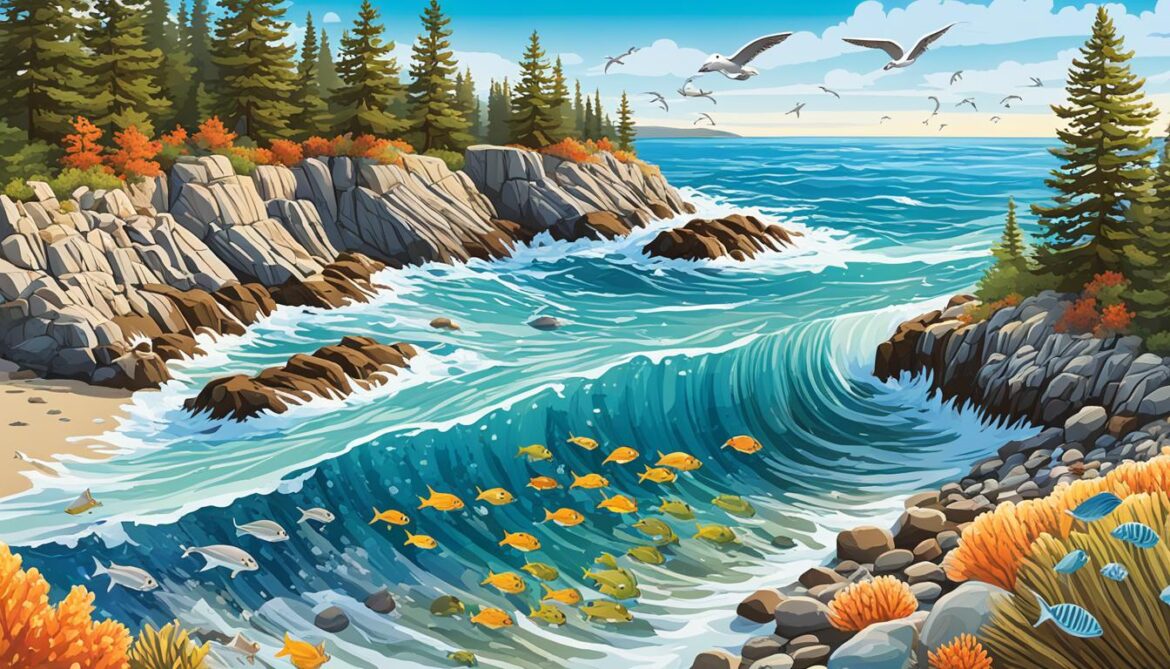
| Threats to Coastal, Marine, and Island Biodiversity |
Conservation Measures |
| Overfishing and unsustainable fishing practices |
Regulation of fishing activities and implementation of sustainable fishing practices |
| Habitat destruction and degradation due to coastal development |
Evaluation of development projects and implementation of sustainable coastal management practices |
| Pollution from industrial activities and marine debris |
Enforcement of environmental regulations and public awareness campaigns on waste management |
Sustainable Agricultural Biodiversity in Eritrea
Agriculture plays a vital role in Eritrea’s economy, and the country’s commitment to maintaining agricultural biodiversity is commendable. Eritrea recognizes the value of preserving crop genetic diversity, including traditional crop varieties, as it ensures the resilience and sustainability of its agricultural systems. Additionally, Eritrea promotes sustainable livestock management practices to protect and enhance livestock diversity in the country.
Eritrea understands that agroecological approaches are key to enhancing the country’s agricultural systems. By utilizing agroecology principles, Eritrea can effectively conserve biodiversity while improving food security. These approaches prioritize the ecosystem’s health and resilience, enhancing the ability of crops to adapt to changing environmental conditions.
To further highlight Eritrea’s commitment to sustainable agriculture, here is a table showcasing the different traditional crop varieties and livestock breeds found in the country:
| Crop Varieties |
Livestock Breeds |
| Teff |
Hamitic |
| Fingermillet |
Ankole |
| Sorghum |
Guinea Hog |
| Barley |
Ongole |
| Wheat |
Somali |
Eritrea’s commitment to preserving agricultural biodiversity not only strengthens its food security but also contributes to the overall health and sustainability of its ecosystems. By valuing crop genetic diversity and promoting sustainable livestock management, Eritrea sets an example for other nations striving to achieve sustainable agricultural practices.
Integrating Biodiversity into Urban Planning
Eritrea is leading the way in incorporating biodiversity concerns into urban planning and architecture. The country is committed to promoting sustainable urban development practices that prioritize the conservation of nature. By integrating sustainable architecture and eco-friendly construction projects, Eritrea aims to create cities that are not only aesthetically pleasing but also in harmony with the natural environment.
Sustainable urban planning in Eritrea involves the careful selection of construction materials that have minimal environmental impact. The use of eco-friendly materials not only reduces the carbon footprint of buildings but also contributes to the preservation of natural resources. Eritrea encourages the adoption of energy-efficient designs, including the implementation of renewable energy systems, to create environmentally friendly cities.
“Our focus is on creating urban environments that support biodiversity conservation while meeting the needs of our growing population,” says Yared Gebre, the Minister of Urban Development in Eritrea.
Eritrea recognizes that incorporating biodiversity into urban planning goes beyond the physical design of cities. It also involves creating green spaces that support wildlife habitats and promote biodiversity. The country encourages the establishment of urban parks, gardens, and green corridors that provide a natural refuge for native plants, animals, and birds.
Benefits of Integrating Biodiversity into Urban Planning
The integration of biodiversity into urban planning brings numerous benefits to both the environment and communities. First and foremost, it helps preserve local ecosystems and protect endangered species by creating designated areas for their conservation. This contributes to the overall health and resilience of ecosystems in urban areas.
Additionally, incorporating biodiversity into urban planning improves the quality of life for residents. Green spaces and urban parks provide recreational opportunities, contribute to mental and physical wellbeing, and enhance the aesthetic appeal of cities. Furthermore, sustainable urban design can promote energy efficiency, reduce pollution levels, and mitigate the heat island effect, resulting in a cleaner and healthier urban environment.
Case Study: Asmara’s Green Urban Development
Asmara, the capital city of Eritrea, serves as an exemplary model for integrating biodiversity into urban planning. The city has implemented innovative strategies to create a sustainable and eco-friendly urban environment.
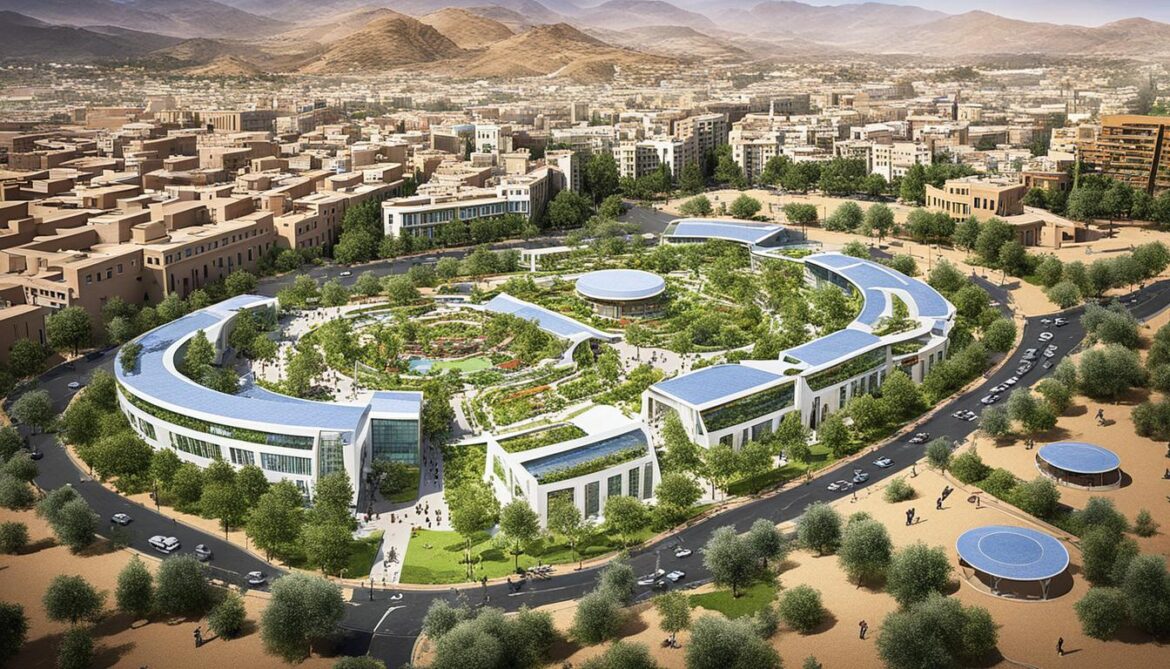
One of the key initiatives in Asmara is the transformation of abandoned or underutilized buildings into green spaces. These spaces, known as urban gardens, serve as community hubs where residents can learn about sustainable gardening practices and urban agriculture. The urban gardens not only contribute to the city’s biodiversity but also empower local communities and promote food security.
Furthermore, Asmara emphasizes the preservation of historic buildings and neighborhoods. This approach not only maintains the city’s cultural heritage but also protects the natural ecosystems present within these urban areas. By preserving and restoring historic buildings, Asmara ensures the sustainable development of the city while promoting biodiversity conservation.
Mapping and Assessing Ecosystems and Their Services
Eritrea is actively engaged in the mapping and assessment of ecosystems and their services to inform sustainable land development policies. Through the use of remote sensing data and expert-based approaches, the country is able to analyze land cover changes and estimate the potential supply of ecosystem services. This valuable information plays a crucial role in guiding decision-making processes and supporting efforts towards more sustainable land use practices.
The mapping of ecosystems allows for a comprehensive understanding of the spatial distribution and extent of different ecosystems within Eritrea. This information serves as a foundation for assessing the ecological and economic value of these ecosystems and the services they provide.
“By mapping ecosystems, we can identify areas of high biodiversity value, critical ecological processes, and key ecosystem services,” says Dr. Maya Ahmed, an environmental scientist involved in ecosystem mapping projects in Eritrea.
The assessment of ecosystem services involves evaluating the benefits that ecosystems provide to human well-being. These services can include the provisioning of food and water, the regulation of climate and natural hazards, the support of pollination and nutrient cycling, and the cultural and recreational value of landscapes.
By assessing ecosystem services, Eritrea gains insights into the contribution of ecosystems to its society and economy, allowing for better-informed decision-making in land development and natural resource management. It also highlights the need to prioritize the conservation and sustainable use of ecosystems that provide vital services for communities and industries.
Ecosystem Mapping and Assessment in Practice
Eritrea’s ecosystem mapping and assessment initiatives involve a combination of remote sensing techniques, field surveys, and expert knowledge. Remote sensing data, such as satellite imagery, is used to identify different land cover types and map the distribution of ecosystems across the country.
Field surveys complement remote sensing data by providing ground-truthing and validation of the mapped ecosystems. These surveys involve collecting data on vegetation types, species composition, and ecosystem functions. They help refine the accuracy and specificity of the ecosystem maps and contribute to a comprehensive understanding of Eritrea’s ecological diversity.
The expert knowledge and involvement of local communities are essential in the mapping and assessment process. Local communities possess valuable traditional knowledge about ecosystems and their services, which enriches the accuracy and relevance of the assessments. Engaging stakeholders and incorporating their perspectives ensures that the mapping and assessment efforts are holistic, inclusive, and locally relevant.

Ecosystem Mapping and Assessment Benefits
The mapping and assessment of ecosystems and their services in Eritrea yield numerous benefits. Some of the key advantages include:
- Identification and prioritization of areas for conservation: Mapping allows for the identification of areas with high biodiversity value or critical ecosystem functions, helping prioritize conservation efforts.
- Evidence-based decision-making: Mapping and assessment provide scientific evidence and insights that inform land use planning, natural resource management, and policy development.
- Enhanced understanding of ecosystem services: The assessment of ecosystem services helps quantify the contributions of ecosystems to human well-being and supports sustainable development planning.
- Monitoring of changes over time: Regular mapping and assessment allow for the monitoring of changes in ecosystems and their services, enabling adaptive management and response to environmental changes.
| Benefits of Ecosystem Mapping and Assessment |
| Identification and prioritization of areas for conservation |
| Evidence-based decision-making |
| Enhanced understanding of ecosystem services |
| Monitoring of changes over time |
Eritrea’s commitment to mapping and assessing ecosystems and their services plays a vital role in promoting sustainable land development and natural resource management. These efforts provide a solid foundation for informed decision-making, ensuring the preservation and sustainable use of Eritrea’s unique and valuable ecosystems.
Challenges and Opportunities for Biodiversity Conservation in Eritrea
Eritrea faces a range of challenges in its efforts to conserve biodiversity. Limited financial resources pose a significant obstacle in implementing comprehensive conservation initiatives. Additionally, the country is confronted with the impacts of climate change, such as habitat loss, species extinction, and altered ecological patterns. Furthermore, Eritrea acknowledges the need for capacity building to enhance its conservation strategies and ensure their effectiveness.
Despite these challenges, Eritrea also embraces opportunities for sustainable development through the preservation and responsible management of its biodiversity. The country can leverage its diverse natural resources to promote eco-tourism, offering visitors unique experiences while supporting local conservation efforts. Moreover, Eritrea recognizes the potential of sustainable agriculture practices, which contribute to food security and preserve agricultural biodiversity. By implementing renewable energy projects, Eritrea can reduce reliance on non-renewable resources and promote a greener future.
Eritrea’s commitment to addressing biodiversity conservation challenges and exploring sustainable development opportunities demonstrates its dedication to a harmonious relationship between nature and human activities.
Key Challenges:
- Limited financial resources
- Climate change impacts
- Capacity building
Opportunities for Sustainable Development:
- Eco-tourism
- Sustainable agriculture
- Renewable energy projects
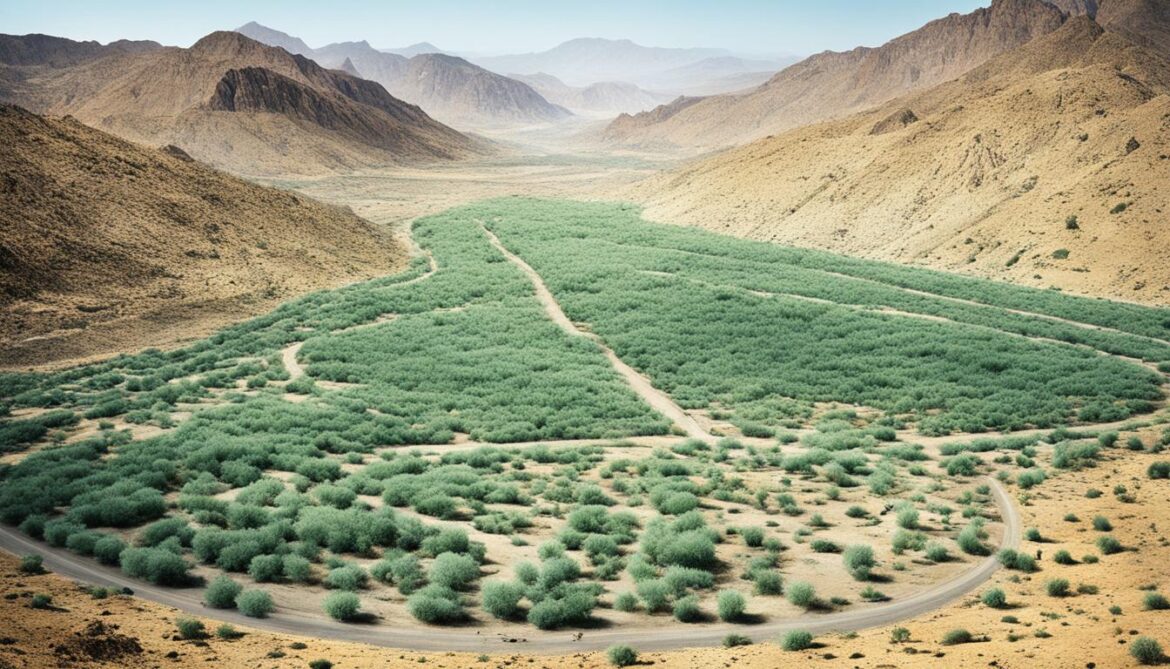
Future Outlook for Biodiversity and the Built Environment in Eritrea
Eritrea is determined to uphold its commitment to biodiversity conservation and sustainable development. The country is dedicated to achieving its biodiversity targets while also making a significant contribution to the global Sustainable Development Goals (SDGs). To accomplish these goals, Eritrea will continue to implement and refine its National Biodiversity Strategy and Action Plan (NBSAP). This comprehensive plan serves as the foundation for Eritrea’s biodiversity conservation initiatives and outlines its vision for a sustainable future.
Eritrea recognizes that the future lies in proactive and forward-thinking biodiversity initiatives. The country is committed to exploring partnerships, collaborations, and international cooperation to facilitate knowledge sharing and best practices in biodiversity conservation. By working with other nations and organizations, Eritrea can leverage collective expertise and resources to address the complex challenges that affect biodiversity on a global scale.
Sustainable Development Goals (SDGs)
Eritrea’s dedication to the SDGs aligns with its commitment to biodiversity conservation. By integrating sustainable development practices into its policies and initiatives, Eritrea aims to contribute to the achievement of several SDGs, including:
- SDG 13: Climate Action
- SDG 14: Life Below Water
- SDG 15: Life on Land
- SDG 11: Sustainable Cities and Communities
- SDG 12: Responsible Consumption and Production
The implementation of the NBSAP, combined with Eritrea’s commitment to the SDGs, presents a promising future for both biodiversity and the built environment. By pursuing sustainable development and effectively managing its natural resources, Eritrea can create an environment that thrives on the harmonious coexistence of nature and human activities.
Eritrea’s future biodiversity initiatives and dedication to sustainability exemplify its role as a responsible global citizen. Through continued collaboration and the pursuit of innovative strategies, Eritrea aims to be a beacon of hope for biodiversity conservation and sustainable development in the region and beyond.
“The earth provides enough resources to satisfy everyone’s needs, but not everyone’s greed.” – Mahatma Gandhi
| Biodiversity Initiatives |
Benefits |
| Expansion of protected areas |
Preservation of fragile ecosystems and endangered species |
| Promotion of sustainable land management practices |
Conservation of soil fertility and prevention of land degradation |
| Research and monitoring programs |
Enhanced understanding of ecosystem health and biodiversity trends |
Conclusion
Eritrea’s commitment to environmental conservation and sustainable development is evident in its efforts to preserve biodiversity and integrate it into urban planning and architecture. The country’s comprehensive National Biodiversity Strategy and Action Plan (NBSAP) serves as a guiding document for its conservation initiatives, ensuring a systematic approach to protecting its unique ecosystems and species.
Eritrea recognizes that the built environment and biodiversity are interconnected, and it strives to maintain a harmonious relationship between the two. Through sustainable land management practices and the establishment of protected areas, Eritrea is actively safeguarding its natural resources for future generations.
By incorporating biodiversity considerations into its urban planning and architecture, Eritrea promotes sustainable development and creates cities that are in harmony with nature. The country’s commitment to preserving and utilizing its rich biodiversity also presents opportunities for eco-tourism, sustainable agriculture, and renewable energy projects, contributing to its overall socioeconomic development.
In conclusion, Eritrea’s dedication to biodiversity conservation and the built environment sets a positive example for other nations. With its National Biodiversity Strategy and Action Plan as a guiding framework, Eritrea continues to strive towards meeting its biodiversity targets and contribute to the global Sustainable Development Goals. By prioritizing environmental sustainability, Eritrea is creating a greener and more prosperous future for its people and the planet.
FAQ
What is Eritrea’s approach to biodiversity conservation?
Eritrea has implemented a National Biodiversity Strategy and Action Plan (NBSAP) that sets out the country’s vision and objectives for biodiversity conservation. This plan focuses on preserving terrestrial biodiversity, coastal, marine, and island biodiversity, and agricultural biodiversity. Eritrea has established protected areas, promotes sustainable land management practices, and monitors biodiversity indicators to ensure the long-term sustainability of its natural resources.
How does Eritrea integrate biodiversity into urban planning?
Eritrea promotes sustainable urban development practices by incorporating biodiversity concerns into its urban planning and architecture. The country emphasizes eco-friendly construction materials and designs that minimize environmental impact. The aim is to create cities that are in harmony with the natural environment and support biodiversity conservation.
What measures has Eritrea taken to conserve coastal and marine biodiversity?
Eritrea recognizes the importance of coastal, marine, and island biodiversity and has implemented measures to protect and conserve these unique ecosystems. This includes the establishment of marine protected areas and the regulation of fishing activities. Eritrea also conducts research and monitoring programs to assess the health and diversity of its coastal, marine, and island ecosystems.
How is agricultural biodiversity preserved in Eritrea?
Agriculture plays a crucial role in Eritrea, and the country emphasizes the preservation of agricultural biodiversity. Eritrea focuses on maintaining crop genetic diversity, including traditional crop varieties, and promotes sustainable livestock management practices. Agroecological approaches are used to enhance the resilience of agricultural systems and ensure food security.
What is Eritrea doing to address biodiversity conservation challenges?
Eritrea faces challenges such as limited financial resources, climate change impacts, and the need for capacity building in biodiversity conservation. However, the country also has opportunities for sustainable development through the preservation and sustainable management of its biodiversity. Eritrea aims to leverage its natural resources to promote eco-tourism, sustainable agriculture, and renewable energy projects.
What is Eritrea’s future outlook for biodiversity and the built environment?
Eritrea is committed to continuing its efforts in biodiversity conservation and sustainable development. The country aims to achieve its biodiversity targets and contribute to the global Sustainable Development Goals (SDGs). Eritrea will continue implementing its National Biodiversity Strategy and Action Plan (NBSAP) and exploring opportunities for partnerships and international cooperation in biodiversity conservation.
Source Links






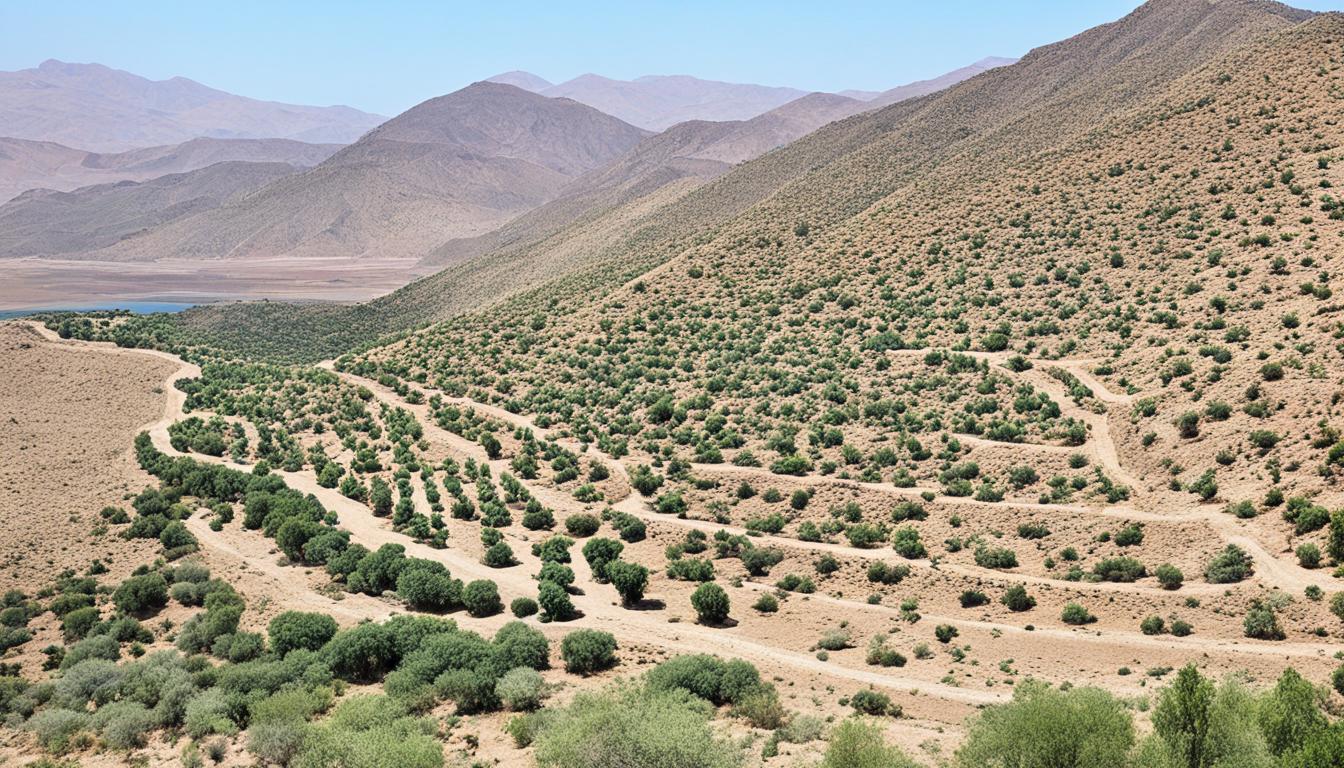


















Post comments (0)